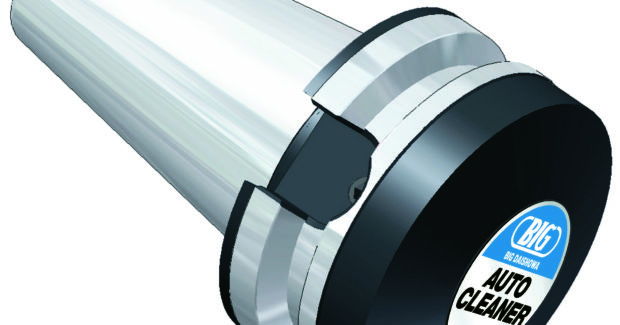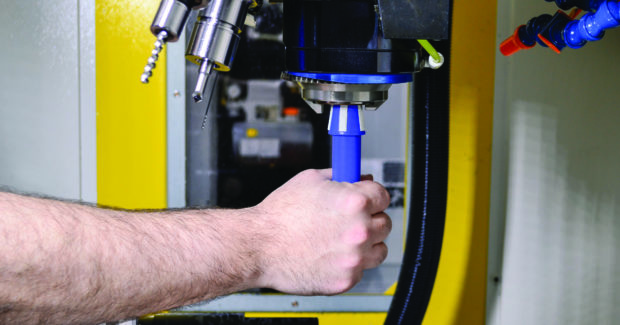Simple Answers to Potentially Costly Spindle and Holder Issues
Maintenance is important and kind of a pain — make use of simple tools and devices to avoid the pain.
Posted: April 18, 2022
While BIG DAISHOWA doesn’t build machines or spindles, we are the innovators of the BIG-PLUS dual-contact holder platform that’s used by about 150 machine builders and 10 other toolmakers. We think about spindles quite a bit, because the simultaneous taper-flange contact of BIG-PLUS makes the integrity of the relationship especially important.
Often, when we dig in with customers who feel their holders aren’t delivering, we find that the root cause of the issue traces back to the spindle. Of course, this scenario isn’t unique to BIG-PLUS. Spindle accuracy ultimately has a direct effect on the accuracy and rigidity regardless of the machine tool, tooling, or cycle.
You don’t need an expensive robot or AI-guided predictive maintenance to do a good job maintaining and inspecting spindles. The principles for maintaining spindles span all tooling formats, machines and shops and there are simple, inexpensive devices that are effective at keeping this crucial link in the machining chain strong.
For starters, the biggest reason for poor performance is a simple lack of cleanliness. It’s not uncommon to see tooling carts covered with film, debris and chips. You’re all but guaranteed to find similar conditions where the tool meets the spindle. Any type of buildup like this will cause tools in the spindle to wobble or rock. Once that starts to happen the system breaks down quickly, wearing visible indentations or circles into the holder, weakening the fit and severely impacting machine accuracy.
Cleanliness and Structural Maintenance Considerations
Keeping the spindle connections clean is important and can be done easily with some simple hand tools. Spindle cleaners, available for all taper types, make it easier to avoid these issues, with ideally spaced and positioned cleaning strips for removing particles, grease and oil residue from critical mating surfaces. Similar designed taper cleaners are handy for removing any debris or buildup from tools (including flanges in the case of BIG-PLUS) that may transfer to the spindle.
If you’re a BIG-PLUS user, a more advanced solution, the BIG-PLUS Cleaner, redirects through-spindle air over the entirety of BIG-PLUS machine spindle interface.
Moving from cleanliness to more structural maintenance considerations in and around the spindle, we come to automatic tool changing (ATC). What does that have to do with spindle maintenance, you ask?
If your machine performs a lot M06 of processes, there’s the risk of your spindle, and ultimately your work, being affected. If that tool changer arm or gripper is misaligned even slightly when it approaches the spindle, it will cause wear on the spindle taper over time as well as more runout and shorter tool life. For your spindles’ sake, it’s best to regularly track and adjust your alignment. This can be done easily with a simple device like our ATC Alignment Tool. It’s inserted into the spindle and measures how accurately the arm approaches.
A spindle’s clamping mechanism will also wear over time. Insufficient retention force can lead to reduced rigidity and vibrations, loss of machining quality and shortened tool life. The first signs of retention issues often appear on the part and can be tricky to diagnose. By then, let’s face it, it’s already too late.
Simple digital devices, like our Dyna Force, make measuring and maintaining spindle retention force fast and easy. The lightweight, compact device allows you to preemptively mitigate the risk of machine damage or poor machining quality resulting from a low force on the spindle. Dyna Force is available for 30, 40 and 50 cones, with one common digital display for all taper sizes. It is also fully compatible with BIG-PLUS spindles.
Like retention force, if a spindle’s static accuracy is fading or bearings are failing, it’s something you’ll want to know sooner than later. Those inaccuracies are only multiplied as the spindle spins at high RPMs and over time. Luckily, this doesn’t require disassembly or deep machine inspection, rather a simple precision test bar tool like Dyna Test. With the help of a dial indicator, you can uncover any runout while safely spinning the spindle at a very low RPM and verify the parallelism of Z-axis motion.
There’s good reason the relatively straightforward idea of predictive maintenance introduced by AI, sensors and robots is one of their most impactful additions to the industry, despite the buzz and staggering potential: maintenance is really important and kind of a pain. When it comes to all-important spindle maintenance, however, you can avoid the pain and without breaking the budget by using simple tools and devices like the ones we’ve talked about.



















